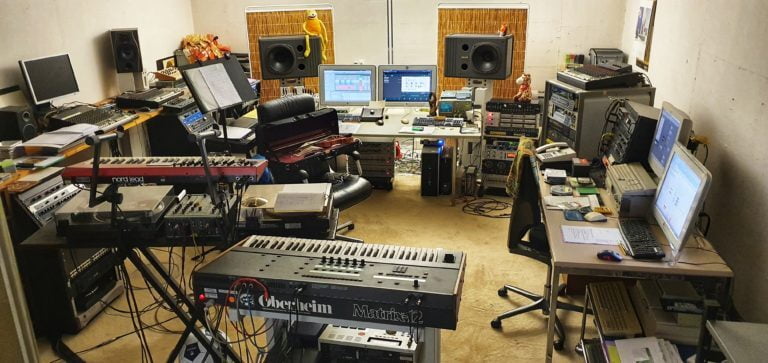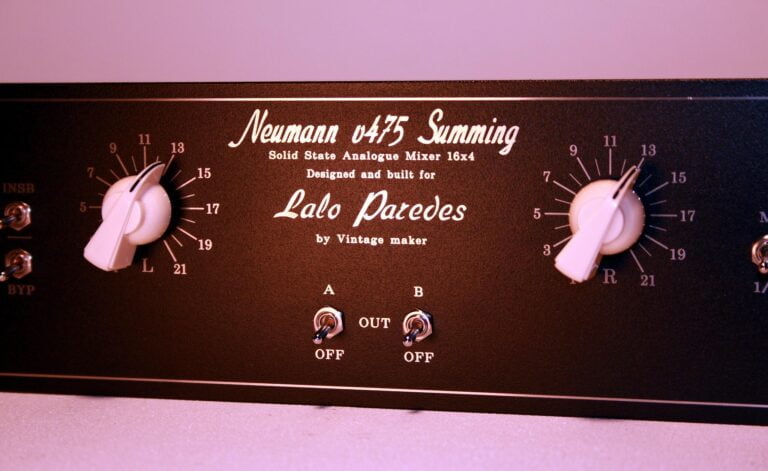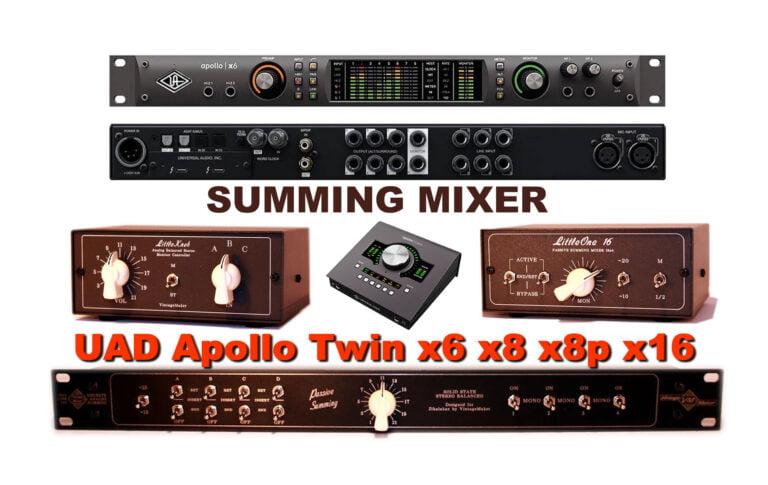What does Analog Summing mixer do
Do I Need Analog Summing?
If you want to sound professional — the answer is YES.
Get that big, warm, no-compromise professional studio sound with VintageMaker’s custom analog summing mixers – real analog warmth, deep stereo imaging, and rich harmonics in a compact, affordable design tailored to your setup, all at an affordable price.
Why should I use an analog summing mixer instead of mixing entirely in the DAW?
- Big studio sound — in your own studio
Get the depth, width, and analog warmth of legendary mixing consoles. - Sound like a pro
Impress your listeners with rich, polished mixes that stand out. - No harsh digital edges — no flat, lifeless digital sound — no computer or plugin power limits.
Say goodbye to cold, flat ITB mixes — enjoy smooth, natural authentic analog character. - Real analog summing — big headroom — safe transients — huge harmonic content!
Not a plugin or emulation — these can never replicate the warmth and richness of 100% discrete analog circuitry that delivers true, big-studio 3D sound, thanks to hardware physics. - Custom Designed to fit your space, studio setup, workflow, and existing cables/connectors
Desktop or rack-mounted design — professional sound, compact format, available in any channel count and type! - Pro-quality sound without the pro price
Get studio-grade warmth and clarity without breaking the bank.
The Sweet Spot: Getting Subtle Harmonic Distortion
By boosting the input gain, you introduce subtle and pleasant analog harmonic distortion. The analog summing headroom (thanks to its physics) allows space for transients and creates beneficial gentle harmonic distortion. This prevents overload and adds warmth, transparency, and more spatial depth. That’s why your music sounds “like a record” — instruments sit better in their place when run through an analog summing mixer.
Just Two key rules to remember — see Step 1 and Step 2 below and you’ll realize how easy it is! Let’s do this!

Main Rule: To get that rich, analog sound, push the instruments into the summing mixer at a high level until gentle harmonic distortion occurs.
This introduces subtle harmonic saturation, adding warmth, depth, and better instrument separation. The analog headroom handles transients naturally, preventing collapse and making your mix sound more like a finished record.
Does Analog Summing Make a Difference?
Is there any Real Value in Summing Mixers ? What does Analog Summing mixer do? Is it Necessary to have a Summing Mixer? How Important is Analog Summing?
You’ve probably asked yourself this question before; you’re not alone; thousands of others have asked it too
So, what does Analog Summing mixer do? It transforms your audio experience by combining multiple audio signals, allowing for a richer and more dynamic sound. To really grasp what does Analog Summing mixer do, consider how it processes signals differently than digital summing solutions.
Short Version Answer: Simple Physics
The SUM BUS – Summing Mixer Input – Internal Resistor Network – provides the SAFE ZONE called Headroom.
Headroom offers a secure – safe space for your audio material. It preserves the separate focus of the instruments and maintains their proper position in the panorama field (Wide Deep 3D Sound). Through proper gain staging (sending a higher-level audio signal to the summing inputs and then hitting or getting the gentle analog harmonic distortion), you maintain and capture the fundamental harmonics in the SUM BUS, which are then summed to a master stereo track.
Discover how Grammy Award-winning producers use the summing mixer to enhance their sound.
How Does Analog Summing Help You Achieve a More Professional Sound for Your Music?
- No Mix Collapse: In an analog summing mixer, your mix will never collapse. This is simple electrical physics—there’s no magic involved.
- No Digital Limitations: In the analog world, there are no 0’s and 1’s—only voltages. This means your final mix can’t collapse, as there are no bits and bytes, no floating-point calculations, just voltage elements with rich harmonic transients.
- More Channels = More Depth: The more channels you use in analog summing—whether 4, 8, 16, 32, or even 48 or 96—the more space and depth you gain in your music. This results in a final mix that sounds wider, deeper in 3D, with improved instrument separation and higher resolution.
Amplifying Harmonics: The VCA Amplifier Effect
What does Analog Summing mixer do? It allows for manipulation of sound in ways that digital summing cannot. For anyone serious about audio, understanding what does Analog Summing mixer do is essential. What does Analog Summing mixer do? It reinvigorates your sound and brings it to life. Thus, what does Analog Summing mixer do? It combines channels in a way that maintains their integrity. Ultimately, discovering what does Analog Summing mixer do can greatly influence your mixing decisions.
Then pass them (main rec — record master stereo) through your DAW interface preamp or a transformer amp. Here, the (VCA) amplifier uplifts and boosts fundamental harmonics (which were created in the sum bus) and introduces additional excitement and saturation, enhancing the complex harmonics and creating the warm analog color character sound.
Main Rule: Analog Separation for 3D Sound
The more channels (4, 8, 16, 32, or even up to 48 or 96) you mix in analog summing, the greater the analog separation in the panorama field, creating a wider, deeper 3D sound.
Exploring Limitless Potential
Essentially, the analog summing potential is nearly limitless; it’s only limited by the number of output channels on your interface. If you’re interested in the extended version, I’ll try to outline the operation of an analog mixer as simply as possible. I know it has been easy for you so far because you’ve been mixing comfortably in the computer DAW — ITB (In The Box) with both its pros and cons.
Transitioning to the Analog World: A New Dimension
However, now, when you step into the real analog world, you’re entering a new dimension. To be successful, you have to understand how this works. Oh, and you need to learn some basic studio laws in theory and practice (I promise it will be simple, and you’ll have a good laugh once you understand how it works). Yes, you must practice to gain your practical experience.
Pro Techniques: Elevating Your Mix Like a Pro
If you simply send your mix through the summing mixer, your music will sound much better… But if you do it like a pro, you can get far superior results.
The Physics Behind Analog Summing
The answer is, it’s easy physics: since analog summing adds space for all harmonic elements, there are no digital 0s and 1s; no floating-point processor calculations — only voltages.
While exporting the project into files (math summation), the digital system slightly rounds off values for level, pan, EQ-ing, and compression, resulting in a final mix collapse that is noticeably audible compared to the pre-export mix (I’m sure you’ve also experienced it).
Preserving Complex Sinusoidal Voltages
So, these complex sinusoidal voltages, comprising both harmonic and non-harmonic elements, including rich harmonics, transients, saturation, and other components, remain intact in their original form within the Analog Summing Mixer.
Sweet Spot: The Art of Subtle Harmonic Distortion
By boosting the input gain, subtle and pleasant analog harmonic distortion is introduced because the Analog Summing Headroom (due to its physics) provides space for transients and beneficial gentle harmonic distortion.
This prevents collapse and delivers ‘pleasant harmonics,’ warmth, transparency, and more spatial depth. This is why your music sounds ‘like a record’; instruments sit better in their place when you run it through an analog summing mixer.
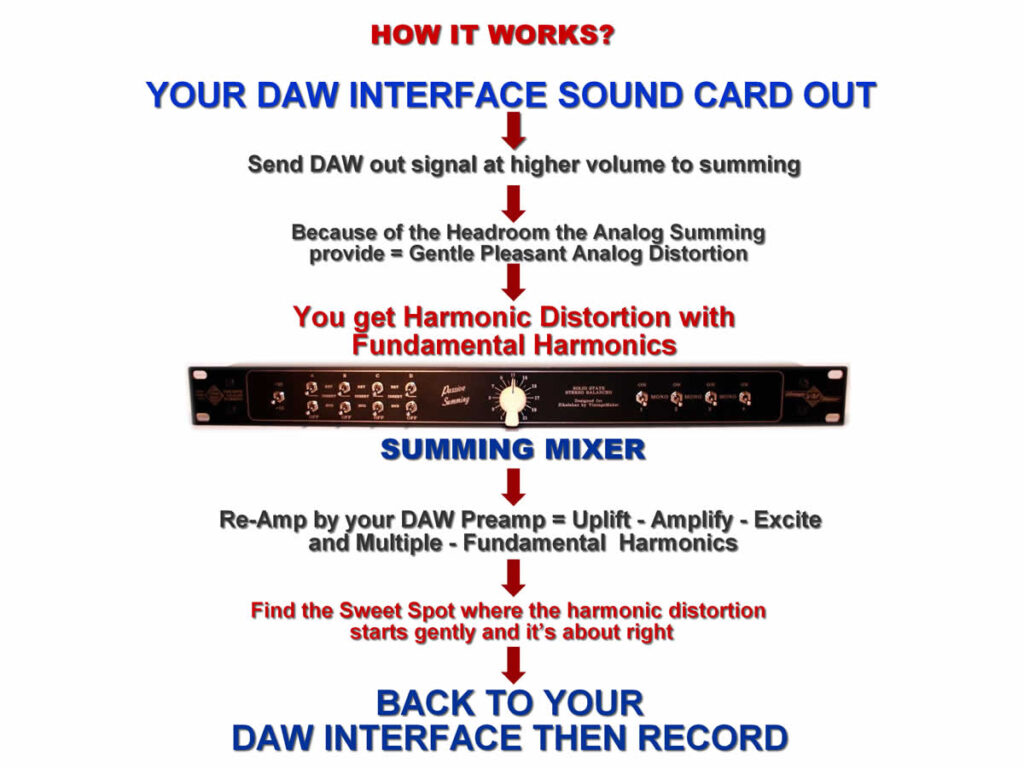
Maximizing Your Summing Mixer Potential
As mentioned, still you’re NOT maximizing the potential of your summing mixer; you’re only utilizing it at a basic level…
You have to extract the best from your summing mixer, and you can only do that if you understand how it works. Imagine: I give you a tool. If you don’t know how to wield it, the results won’t be outstanding. However, if you learn to handle it at a professional level, you’ll create and achieve fantastic results.
Unveiling the Secrets: Crucial Aspects of Analog Mixing
Many music producers don’t know or don’t consider or ignore the base principles of analog mixing, even though it is very important and easy to understand. The following aspects are crucial in analog mixing to attain a genuinely unique and authentic Big Studio Analog Sound. I have many well-known big studios and Grammy-winning producer clients who use passive and active (or both) summing mixers with great success.
First Stage / Part 1: SUM BUS Analog Summing Inputs – Summing network - Headroom - Harmonic Distortion
This is essentially the mixer inputs, the part of the summing mixer where the input signals are directly connected, right after the interface outputs. It’s the post-input resistor network circuit, commonly known as the SUM BUS. It has been uniquely developed over the years, taking into account user feedback, to achieve uncompromised usability and configurability. It’s essentially manufactured to suit the user’s taste and studio setup DAW interface configuration.

Analog Headroom Protection: Ensuring Instrument Integrity
The SUM BUS — summing mixer input resistor network provides the SAFE ZONE called Headroom. The most important benefits under the protection of the Analog Headroom:
- Maintain Instruments Integrity — Separation — in the panorama field
- Preventing mix collapse, maintaining harmonics, transients, and saturation
- Generate Fundamental Gentle Analog Harmonic Distortion
Preventing mix collapse, maintaining harmonics, transients, and saturation

Analog Summing Versatility: No Input Limit
Facts: Analog summing has no input limit from a mixing perspective; it can easily sum together 8–16–32–64 up to 96 input channels. There are no floating-point mathematical processor calculations as seen in digital summing.
When digitally printing to a file, certain parts of the mix or some instruments may become less distinct or muddy compared to the pre-export mix, in contrast to how the mix sounded before exporting.
Enhanced Separation for Depth: Channel Count Matters
The more channels (4, 8, 16, 32, or even up to 48 or 96) you mix in analog summing, the greater the analog separation in the panorama field, creating a wider, deeper 3D sound.
How to Attain Subtle Analog Harmonic Distortion in the Summing?
Once you’ve found the right placement — location for your instruments in the panorama field (where they sit better), you gently begin to increase step by step the volume of the main instruments or what you want to highlight — or make it more focused — is like pulling the focus of a camera lens (or on all tracks / increase the volume of the whole mix simultaneously) until you hear them filling the space (without overpowering the surrounding instruments). Finally, find the point where the harmonic distortion just begins or starts to come into existence.
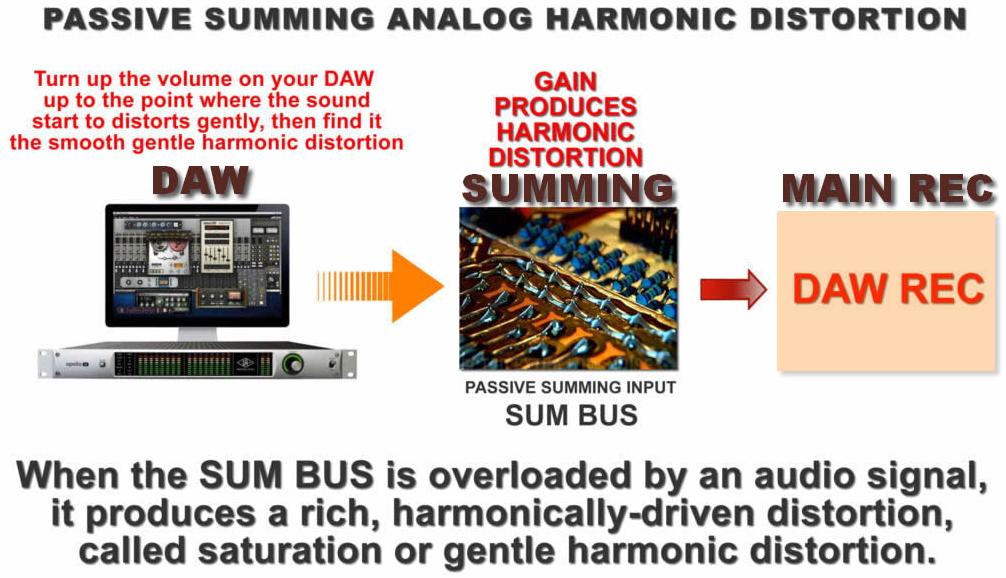
Rule: Boosting DAW Output levels
Simply boost your DAW output level (master fader), and you’ll get some pleasant, gentle distortion as you drive the SUMMING INPUTS (SUM BUS) above its nominal level and find the “Sweet Spot.
Second Stage / Part 2: Boost / Attenuate / Amplify Harmonics -Gain Staging - Sweet Spot - after Sum Bus – on master stereo out
Gain staging is the process of making sure the audio volume is set to an optimal level for the next processor in the chain (final DAW record or external process in outboard, EQ, Comp, etc.) You should find the maximum volume that your DAW interface or mic preamp input can handle without distortion, typically in increments of 0.1–0.2 dB, to get the best setting. The analogy applies here as well: it’s like pulling the focus of a camera lens. By proper gain staging through your analog and then your digital systems, you can achieve the best possible balanced and saturated sound for your recording. When asking, What does Analog Summing mixer do, it’s crucial to consider the benefits it brings to audio mixing. Understanding what an Analog Summing mixer does can significantly enhance your production quality.
How can I get it?
You can use your DAW interface’s Mic Preamp or transformer amp/amplifier to boost the signal on the summing outputs; you can also use your line-level inputs on your audio interface, your outboard preamps, or internal transformer amp (Active summing like Neumann), each providing a different color.
Amplifying Harmonics and Adding Excitement
With signal amplification, you achieve the following:
- Harmonics amplification — amplifying the fundamental harmonics generated on passive summing (sum bus) inputs.
- Excite and add harmonics — creating both even and odd harmonics using a transformer pre-amp or tube amp.
Pre-amp Plugin Emulations: Many of my clients have achieved excellent results with the well-known UAD Apollo Unison preamps. These pre-amp emulations have surprisingly delivered outstanding results, to the point where you can hardly tell on the first listen that it’s an emulation; it sounds soo good!
When considering the role of an Analog Summing mixer, think about its impact on achieving audio integrity. It combines audio channels while preserving their individual qualities, enhancing the overall sonic experience for listeners. In live performances, it ensures clarity and richness, making the sound more immersive. If you’re still unsure about its benefits, consider how it refines mixing workflows and introduces the essence of analog warmth into your recordings.Ultimately, understanding an Analog Summing mixer leads to a deeper appreciation of audio production and its ability to elevate-upgrade your sound and mixing strategy.
Understanding What an Analog Summing Mixer Does
Ultimately, what does Analog Summing mixer do? It delivers a unique sonic character that is often sought after in high-quality audio productions.
Understanding what an Analog Summing mixer does is key to elevating your audio mixing game. Every producer should grasp its impact, as it enhances clarity, depth, and overall mix quality. Analog summing improves instrument separation, preserves detail, and creates a more immersive sound stage. By interconnecting audio signals, it introduces richer harmonics and optimizes dynamic range. Curious about how it fits into your setup? Experimenting with an analog summing mixer in various mixing scenarios will help you appreciate its value. It enriches audio quality, adds warmth, and delivers a professional finish that’s hard to replicate digitally.In essence, an Analog Summing mixer transforms your mix, giving it depth, cohesion, and a refined analog character. When exploring what does Analog Summing mixer do, remember that it plays a pivotal role in achieving a professional sound.
Pro Tip: Push the instruments into the summing mixer at a higher level until you start hearing a subtle harmonic distortion. This will add warmth, depth, and better separation to your mix, giving it a more professional, polished sound—just like a finished record.
Common Questions About Analog Summing
- What is analog summing and how does it work?
- Why should I use an analog summing mixer instead of mixing entirely in the DAW?
- Does analog summing really improve the sound quality?
- What are the benefits of analog summing compared to digital summing?
- Can I use analog summing with any DAW?
- Is analog summing suitable for home studios or just professional studios?
- How many channels can an analog summing mixer handle?
- What is the difference between an analog summing mixer and a summing box?
- Do I need special cables or interfaces to use analog summing?
- Will analog summing add noise or distortion to my mix?
- How does analog summing affect stereo width and depth?
- Can I automate parameters when using analog summing?
- Is analog summing compatible with outboard gear like compressors and EQs?
- How expensive is a good analog summing mixer?
- Does analog summing require more maintenance than digital mixing?










